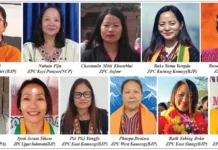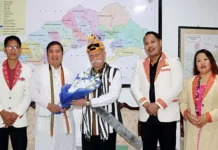[ Ripi Bagra ]
Nestled high in the easternHimalayas, Tawang, a picturesque district of Arunachal Pradesh, finds itself at the crossroads of geopolitical contestations between India and China. With its towering peaks, ancient monasteries, and unique blend of cultures, Tawang has become a focal point of strategic, political, and territorial contestations between the two Asian giants. Tawang’s significance in the geopolitical chessboard dates back to the early 20th century when the McMahon Line was drawn, demarcating the border between British India and Tibet. Post-independence, China rejected this line, leading to territorial disputes and, eventually, the 1962 Sino-Indian war, a watershed moment in the history of both nations, has significantly shaped the trajectory of Sino-Indian relations and left a lasting impact on the geopolitical landscape of the region. The lingering border issue has left Tawang at the centre of diplomatic tensions, with both nations claiming sovereignty over the territory.
At the heart of Tawang lies the Tawang monastery, a sacred seat of Tibetan Buddhism and one of the largest monasteries globally. This ancient institution, with its golden spires and rich tapestry of Buddhist art, serves as a cultural and spiritual focal point for the region. Beyond its cultural and historical importance, Tawang holds strategic value due to its proximity to the disputed border and its elevation, offering a commanding view of the region. The disputed border in Tawang has been a source of periodic tensions and military standoffs. Both nations have fortified their positions, with the border areas witnessing occasional skirmishes. The 1962 war and subsequent conflicts have left an indelible mark on the security landscape of Tawang. The military postures of both nations in the region reflect the strategic imperative they place on securing this high-altitude terrain. There was a face-off between the Indian Army and the PLA in the Yangtse sector of Tawang as recently as December 2022.
Caught in the geopolitical crossfire, Tawang faces unique challenges in terms of development.
While efforts have been made to improve infrastructure, connectivity, and socioeconomic conditions, the unresolved border dispute has sometimes hindered comprehensive development initiatives. Over the years, the Indian government has initiated various developments in Tawang to address infrastructural, economic, and social needs. Balancing the needs of the local population with strategic imperatives is a delicate task, as infrastructure projects and economic development can become entangled with geopolitical considerations. New Delhi is actively advancing infrastructure development in Arunachal, undertaking projects from road construction to establishing a new airport. The focus is on accelerating infrastructure initiatives, with a particular emphasis on border linkages, and the central component of these efforts is the Arunachal Frontier Highway. Tawang’s tourism potential remains immense, offering visitors breathtaking landscapes, cultural experiences, and the tranquillity of its monastic heritage. The economic opportunities tied to tourism could be a catalyst for sustainable development, provided these initiatives are navigated judiciously, considering both environmental and cultural sensitivities.
As Tawang continues to be under the shadow of India-China tension, the path forward involves nuanced diplomacy, sustained dialogue, and a commitment to finding peaceful resolutions. Recognising the cultural significance of the region, fostering local development, and addressing security concerns are integral to charting a course that respects the people’s aspirations while navigating the complexities of the broader geopolitical landscape. In conclusion, Tawang symbolises the intricate interplay between history, culture, and geopolitics. Its unique position encapsulates the challenges and opportunities that arise when a region becomes entangled in the geopolitical dynamics of neighbouring nations. The road ahead for Tawang requires careful navigation, acknowledging its cultural heritage while fostering development and working towards resolving the longstanding border dispute. [The contributor is a PhD research scholar at Jawaharlal Nehru University, New Delhi.]




